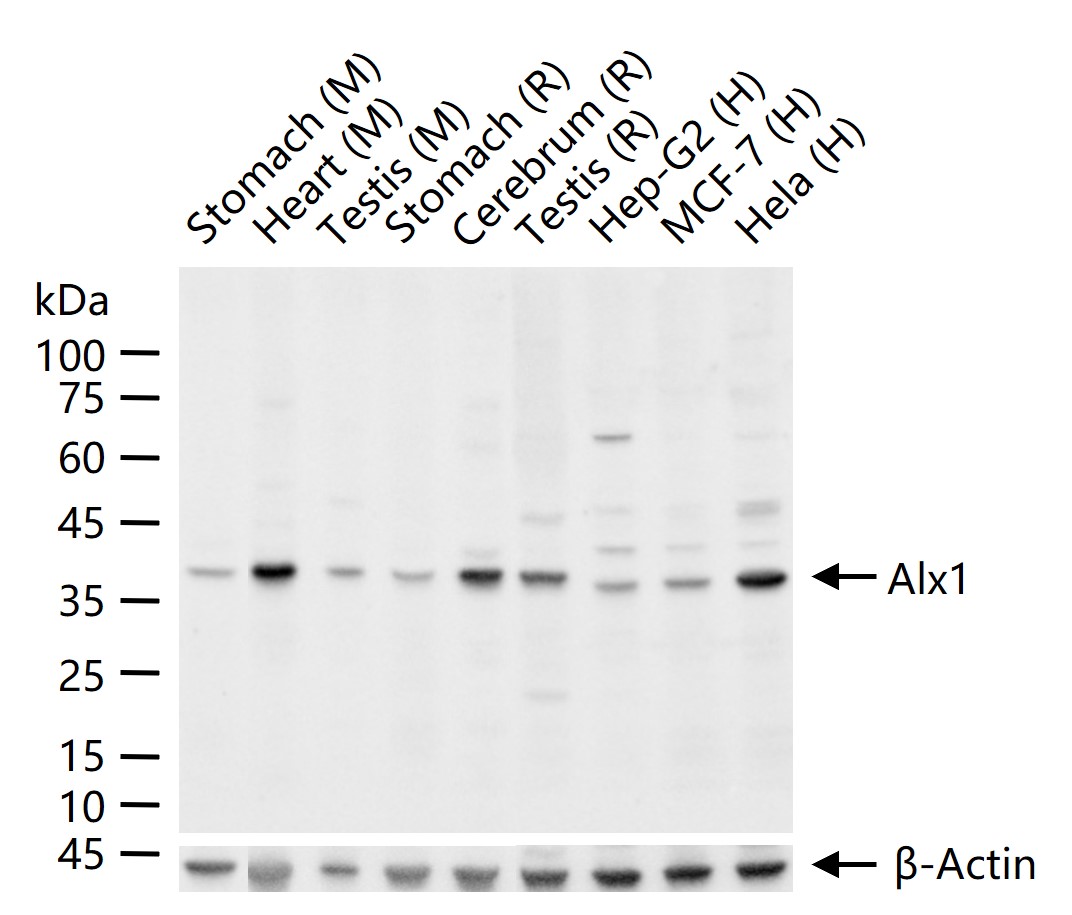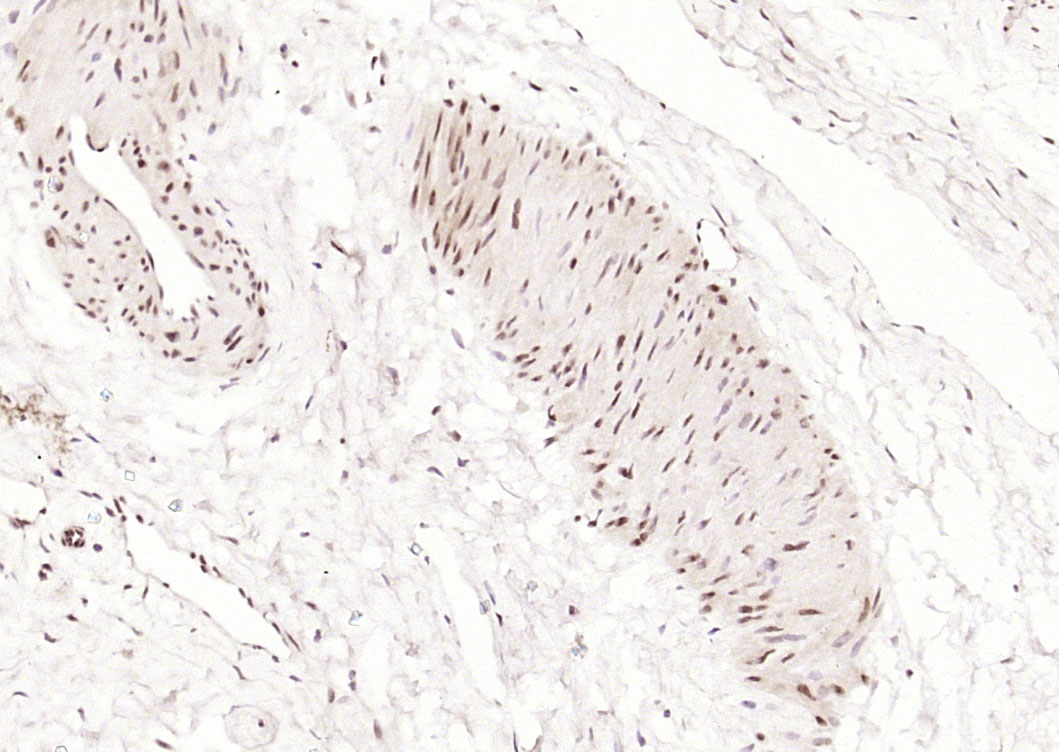Alx1 Rabbit pAb
Alx1 Rabbit pAb
- 产品详情
- 实验流程
- 背景知识
Application
| WB, IHC-P, IHC-F, IF |
|---|---|
| Primary Accession | Q15699 |
| Reactivity | Human, Mouse, Rat |
| Predicted | Dog, Horse, Rabbit |
| Host | Rabbit |
| Clonality | Polyclonal |
| Calculated MW | 36961 Da |
| Physical State | Liquid |
| Immunogen | KLH conjugated synthetic peptide derived from human Alx1 |
| Epitope Specificity | 231-326/326 |
| Isotype | IgG |
| Purity | affinity purified by Protein A |
| Buffer | Preservative: 0.02% Proclin300, Constituents: 1% BSA, 0.01M PBS, pH7.4. |
| SUBCELLULAR LOCATION | Nucleus. |
| SIMILARITY | Belongs to the paired homeobox family. Contains 1 homeobox DNA-binding domain. |
| SUBUNIT | Interacts (via homeobox domain) with EP300. |
| Post-translational modifications | Acetylated at Lys-131 by EP300, leading to increased interaction with EP300 and enhances transcriptional activation activity. |
| DISEASE | Defects in ALX1 are the cause of frontonasal dysplasia type 3 (FND3) [MIM:613456]. The term frontonasal dysplasia describes an array of abnormalities affecting the eyes, forehead and nose and linked to midfacial dysraphia. The clinical picture is highly variable. Major findings include true ocular hypertelorism; broadening of the nasal root; median facial cleft affecting the nose and/or upper lip and palate; unilateral or bilateral clefting of the alae nasi; lack of formation of the nasal tip; anterior cranium bifidum occultum; a V-shaped or widow's peak frontal hairline. |
| Important Note | This product as supplied is intended for research use only, not for use in human, therapeutic or diagnostic applications. |
| Background Descriptions | The specific function of this gene has yet to be determined in humans; however, in rodents, it is necessary for survival of the forebrain mesenchyme and may also be involved in development of the cervix. Mutations in the mouse gene lead to neural tube defects such as acrania and meroanencephaly. [provided by RefSeq, Jul 2008]. |
| Gene ID | 8092 |
|---|---|
| Other Names | ALX homeobox protein 1, Cartilage homeoprotein 1, ALX1 (HGNC:1494) |
| Target/Specificity | Cartilage and cervix tissue. |
| Dilution | WB=1:500-2000,IHC-P=1:100-500,IHC-F=1:100-500,IF=1:100-500 |
| Storage | Store at -20 °C for one year. Avoid repeated freeze/thaw cycles. When reconstituted in sterile pH 7.4 0.01M PBS or diluent of antibody the antibody is stable for at least two weeks at 2-4 °C. |
| Name | ALX1 (HGNC:1494) |
|---|---|
| Function | Sequence-specific DNA-binding transcription factor that binds palindromic sequences within promoters and may activate or repress the transcription of a subset of genes (PubMed:8756334, PubMed:9753625). Most probably regulates the expression of genes involved in the development of mesenchyme-derived craniofacial structures. Early on in development, it plays a role in forebrain mesenchyme survival (PubMed:20451171). May also induce epithelial to mesenchymal transition (EMT) through the expression of SNAI1 (PubMed:23288509). |
| Cellular Location | Nucleus |
| Tissue Location | Cartilage and cervix tissue. |
Research Areas
For Research Use Only. Not For Use In Diagnostic Procedures.
Application Protocols
Provided below are standard protocols that you may find useful for product applications.
BACKGROUND
The specific function of this gene has yet to be determined in humans; however, in rodents, it is necessary for survival of the forebrain mesenchyme and may also be involved in development of the cervix. Mutations in the mouse gene lead to neural tube defects such as acrania and meroanencephaly. [provided by RefSeq, Jul 2008].
终于等到您。ABCEPTA(百远生物)抗体产品。
点击下方“我要评价 ”按钮提交您的反馈信息,您的反馈和评价是我们最宝贵的财富之一,
我们将在1-3个工作日内处理您的反馈信息。
如有疑问,联系:0512-88856768 tech-china@abcepta.com.
¥ 1,500.00
Cat# AP57794























 癌症的基本特征包括细胞增殖、血管生成、迁移、凋亡逃避机制和细胞永生等。找到癌症发生过程中这些通路的关键标记物和对应的抗体用于检测至关重要。
癌症的基本特征包括细胞增殖、血管生成、迁移、凋亡逃避机制和细胞永生等。找到癌症发生过程中这些通路的关键标记物和对应的抗体用于检测至关重要。 为您推荐一个泛素化位点预测神器——泛素化分析工具,可以为您的蛋白的泛素化位点作出预测和评分。
为您推荐一个泛素化位点预测神器——泛素化分析工具,可以为您的蛋白的泛素化位点作出预测和评分。 细胞自噬受体图形绘图工具为你的蛋白的细胞受体结合位点作出预测和评分,识别结合到自噬通路中的蛋白是非常重要的,便于让我们理解自噬在正常生理、病理过程中的作用,如发育、细胞分化、神经退化性疾病、压力条件下、感染和癌症。
细胞自噬受体图形绘图工具为你的蛋白的细胞受体结合位点作出预测和评分,识别结合到自噬通路中的蛋白是非常重要的,便于让我们理解自噬在正常生理、病理过程中的作用,如发育、细胞分化、神经退化性疾病、压力条件下、感染和癌症。







